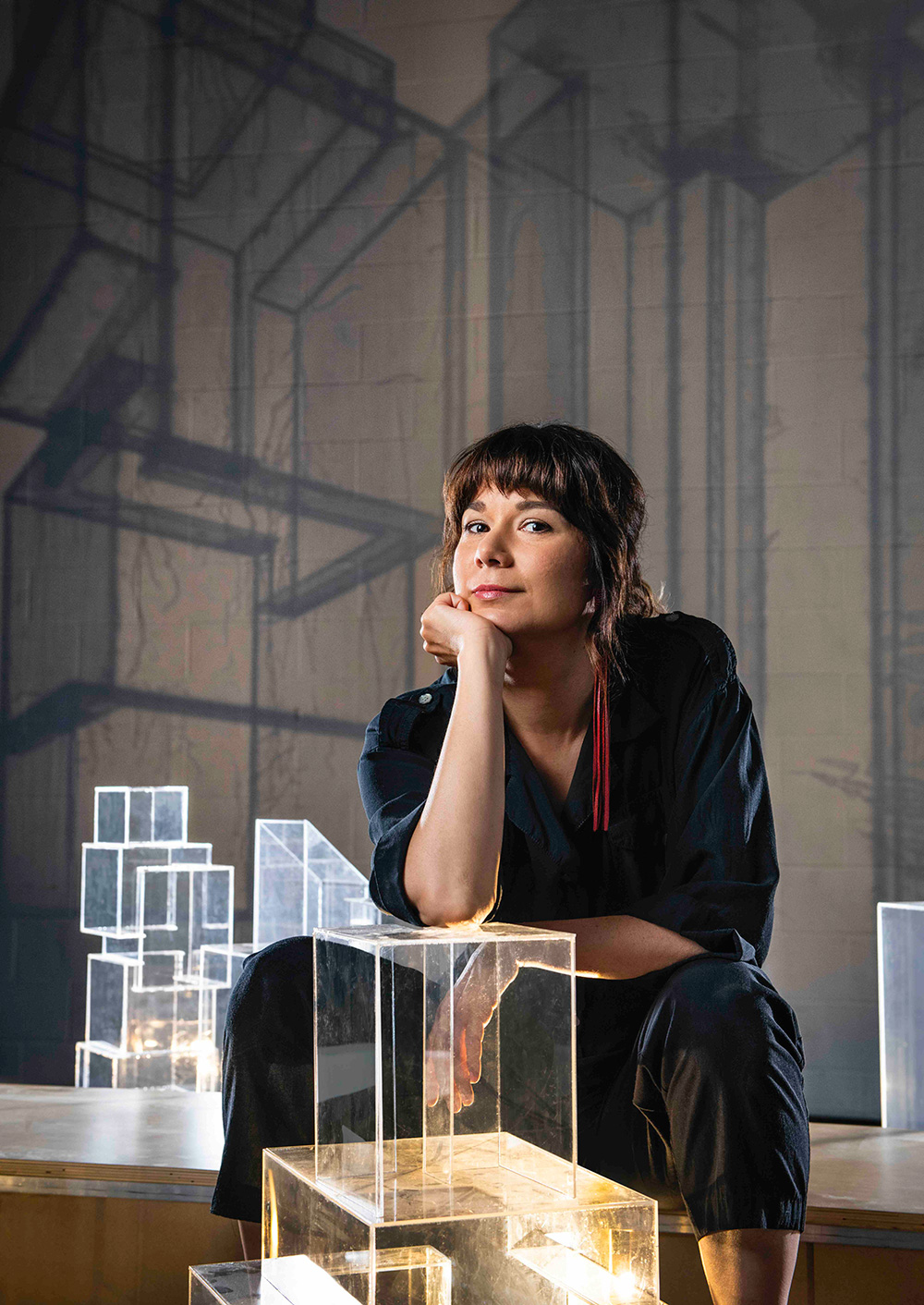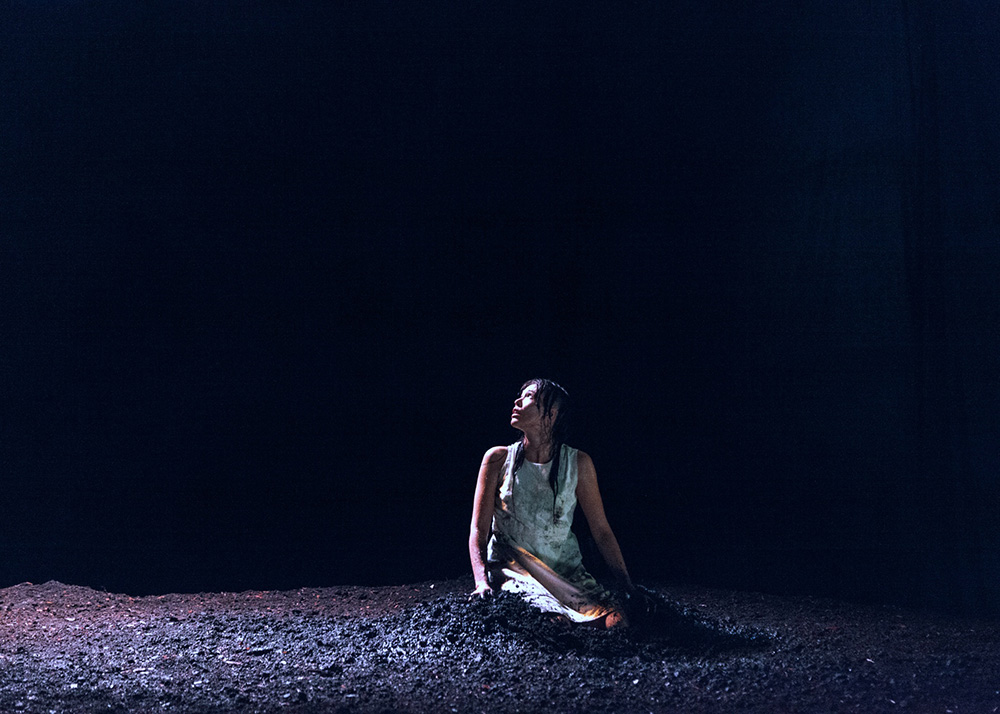Language creates reality.
Nothing makes this idea more radically, physically apparent than Lisa Jackson’s new installation Transmissions.
For Jackson, an Anishinaabe filmmaker, the project represents the convergence of many ideas she has previously explored in her films and virtual reality work. Some of these investigations took flight in Biidaaban: First Light, a VR project created with the National Film Board that offered a futurist vision of downtown Toronto reclaimed by the natural world. Drowned subways, office towers crawling with vines, and everywhere language — scrawled across the sky and spoken gently inside one’s head. The work used several different languages, including the written text of the Wendat, Kanien’kehá:ka (Mohawk) and Anishinaabe (Ojibwa), to create a fully fleshed virtual world.
Biidaaban’s Indigenous Futurism might initially look bleak and dystopic, but a deeper dive revealed a resilient sense of hope and rebirth. Life had returned, taking back the hard sterility of concrete and glass and transforming it into something infinitely more vibrant. Humans had a place in this new world, albeit a diminished one. In the middle of Toronto’s Nathan Phillips Square was a small tent, lit from within.
When I saw this work for the first time, the sense of warmth and comfort — the flickering glow of a campfire set against the spangled infinity of the night sky — stayed with me long after the other details had washed away. There is something of this same comfort in Transmissions, making you want to move in and live there for a while.
On the opening night of the work at SFU Woodward’s, with the space crowded with other folk eager to see the show, it was difficult to linger. The joy in a community coming together was palpable and alive, an electric and crackling form of happiness that moved around the room as speakers, singers and academics spoke.
In introduction to Jackson and her work, Audrey Siegl (sχɬemtəna:t, St’agid Jaad), an independent activist from the unceded lands of the Musqueam said: “It’s like you’ve gathered all these eggs from all of these different places around the country from coast to coast, and made a basket,” she said.
It’s a good image, summing up the collected experience contained in the work — film, sound and story — gently nestled together, waiting to open.

A few days after the opening, The Tyee sat down to talk to Jackson. The conversation ranged from the complexities of building a large-scale installation to the mysteries of dark matter. The communication networks of mycelium, the affinities of linguists and animators, and the wisdom and language of trees also popped up.
As Jackson explained, Transmissions had been a long time in gestation, with some of the ideas first emerging in a workshop she took with documentary filmmaker Jennifer Baichwal. But the final inspiration came in a flash, within the space of a few minutes.
“Make it like you saw it,” said Jackson.
After years of grants, gathering partners and figuring out the complexities of budgeting, the installation came together with the support of the cultural partners Violator Films, Electric Company Theatre and SFU Woodward’s Cultural Programs.
The experience of walking through a physical space is markedly different than the floating ephemerality of VR. Transmissions gets inside of you, as much as you are inside it. The installation unfolds in three sections, taking over the 6,000-square-feet of the Fei & Milton Wong Experimental Theatre.
The entry way is part birth canal and part cathedral, cityscapes and forest flickering into each other. In the first chamber is a video featuring performer Jeneen Frei Njootli clawing at the earth, while rain buckets down, soaking her to the skin. Watching Njootli, I was reminded of Rebecca Belmore’s stunning work in Facing the Monumental. That exhibition premiered at the Art Gallery of Ontario and is currently on display at the Musée d’art contemporain in Montréal. Belmore’s visceral, physical work shares some of the same full-frontal display of agony contained in the image of the digging woman.
While Jackson is similarly interested in destabilizing audiences to allow authentic and sometimes wrenching experiences to emerge, her work is imbued with a febrile brand of hope. She talks about walking through Transmissions with a friend, who burst into tears after watching the film. “I’m sorry you’re crying, but I’m actually really happy. It’s what I wanted it to be,” she said.
The perceptual shift — experiential, tactile — provided by an installation is a critical aspect of the work. Listening, feeling, smelling and touching create a cumulative effect as you move through the different sections. The call of a raven, the sound of wind and water combine with compositions by Laura Ortman and Raven Chacon and the languages of First Nations people.
A key part of Transmissions is the hangout space in the mezzanine area above the installation. It is here where the full body of research funnelled into the work is accessible in film clips, audio files and displays. It is an ocean of information about the way language works.
Jackson is careful not to overly define what the experience should be, allowing for diverse reactions. In researching the work, she collaborated closely with a number of First Nations communities so that it was reflective of and deeply respectful of different traditions. This depth of care is in evidence in the central dome of the work, where audience members can sit on wooden stumps inside the warm confines of a tent-like space, listening to people tell their stories.
Jackson edited the material she collected down from 35-ish hours to 80 minutes (in English), and another 35 minutes of Indigenous languages. The stories are spread across four different channels, and there is a sense of chance as each seat offers the opportunity to listen to different people — elders alongside learners, artists and experts offering a multiplicity of perspectives.
One of the speakers is artist Marianne Nicolson, who describes the differences between Kwak'wala language and English. As she explains in her narration, English is primarily a noun-based language, whereas Kwak'wala is verb-based, meaning that it is innately more active. As Nicolson says, it is far easier to objectify things in English, while Kwak'wala offers a radically different way of understanding the world. Arguably, it creates a more connected and nuanced way of understanding the intricate traceries that radiate out from family to community to the natural world. The preservation of language is more than simply ensuring cultural survival, Nicolson says. It also offers a different way to exist, a necessary tool of change as people face the threat of a warming planet.
The process of reconnecting to the past and the wisdom of elders is a big part of Transmissions, but it also explores the ways language is always changing, adapting to the way that actually people live now. By way of illustration, Jackson talks about the experience of two women conversing in their own language and realizing that certain words weren’t used anymore because people didn’t live the same way. The names of tools, like those used to break through ice, had become anachronisms and fallen out of use.
While Jackson was happy to talk to many people while making her work, she said there is also a lot to be learned from trees and other non-human elements. Ancient trees like the bristlecone pine, as well as quaking aspen and paper birch, played a role.
“Trees are old beings,” Jackson explained, as well as being some of the largest organisms on the planet. Although they are dwarfed in size by the largest organism in the world — a mycelium mat, stretching over 2,400 acres in eastern Oregon, estimated to be 2,200 years old. Many organisms have their own form of language and communication, which often takes the form of music. Sound designer Shawn Cole worked with Tosca Teran’s Midnight Mushroom Music for the Transmissions soundscape. It’s an otherworldly hymn that resounds on an almost cellular level.
Whether it’s the fungal networks beneath our feet or the vault of sky over our heads, what’s visible and invisible constitutes only part of the reality in which we exist.
“The city is seen as so solid, but how solid is reality, really?” asks Jackson. “Humans can’t think on a long curve of time.”
But a language of connection allows for the conception of other realities and a greater sense of continuity stretching in multiple directions — past, present and future. “Not to be a Pollyanna, but it definitely feels like a cultural resurgence is happening,” she said.
A symposium on the installation is planned for Friday at SFU Woodward’s. Curated by Karrmen Crey and Kate Hennessy, The Roots of Meaning will include a tour of the work, followed by discussion and knowledge-sharing around ideas of Indigenous Futurism and language ecologies.
'Transmissions' runs until Sept. 28 at SFU Woodward’s, Tuesday through Friday from 1 p.m. to 7 p.m. and on weekends from 1 p.m. to 5 p.m. Entry is free. ![]()
Read more: Indigenous, Film
















Tyee Commenting Guidelines
Comments that violate guidelines risk being deleted, and violations may result in a temporary or permanent user ban. Maintain the spirit of good conversation to stay in the discussion.
*Please note The Tyee is not a forum for spreading misinformation about COVID-19, denying its existence or minimizing its risk to public health.
Do:
Do not: